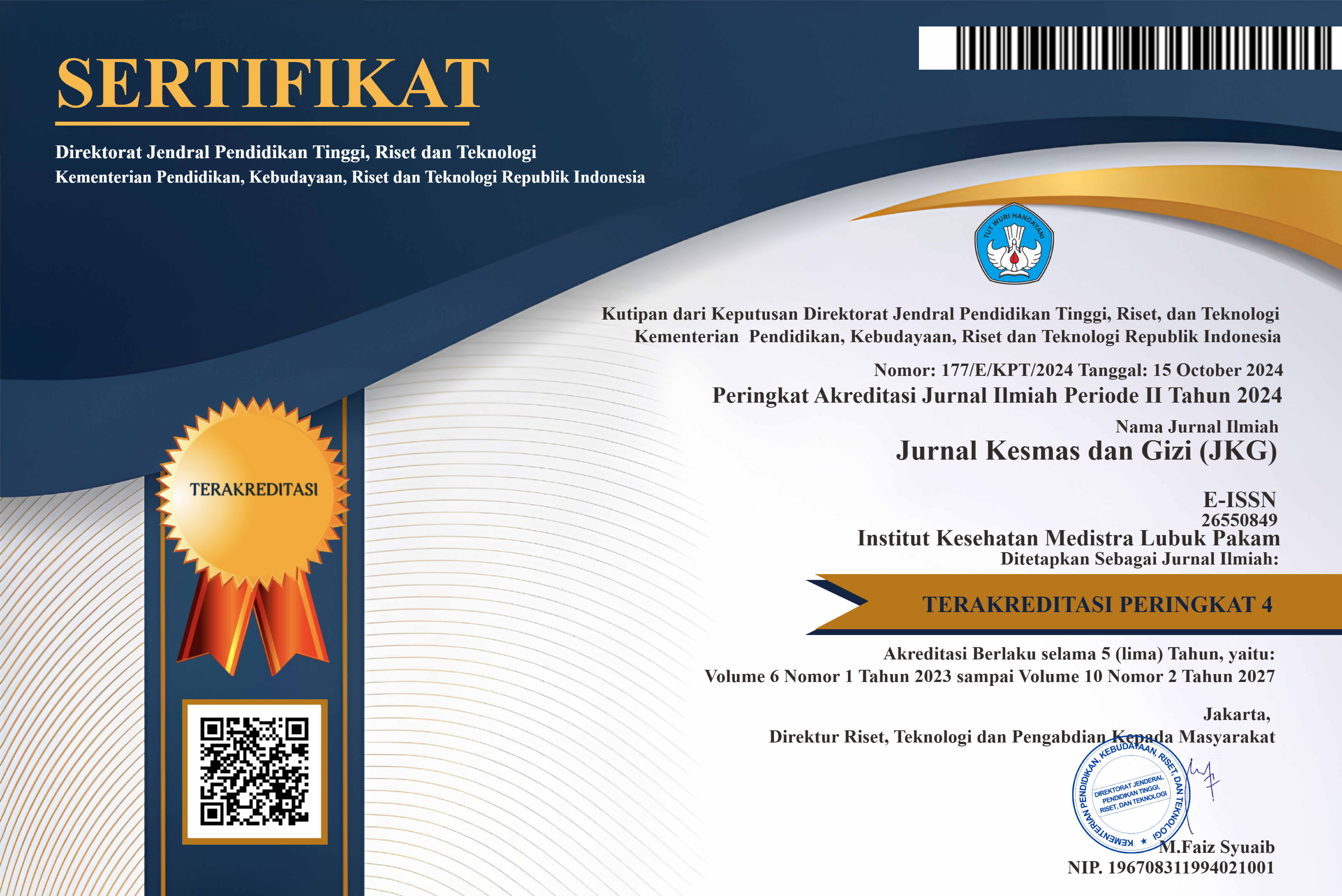REQUIREMENTS OF CARBOHYDRATES, PROTEINS, FATS, PHYSICAL ACTIVITY, AND THE MENSTRUAL CYCLE OF ADOLESCENTS IN SURABAYA
DOI:
https://doi.org/10.35451/jkg.v6i1.1788Keywords:
level of consumption of macronutrients, level of physical activity, menstrual cycle, female studentsAbstract
The menstrual cycle is a crucial thing for women. Irregular menstrual cycles can interfere their mental, physical, and even social lives. Disorders of the menstrual cycle are closely related to several factors, including intake of macronutrients and physical activity. The purpose of this study was to determine the correlation between levels of consumption of macronutrients and physical activity with the menstrual cycle. It was a cross-sectional study with 75 female students of the Nutrition Departement at State University of Surabaya who were taken with non-probability sampling. SQ-FFQ were used to estimate dietary intake of macronutrient, physical activity level were measured by using IPAQ-SF questionnaire, and menstrual cycle data were recorded using the menstrual cycle form using the self-record method. The correlation test between the level of consumption of macronutrients and physical activity with the menstrual cycle are using the Spearman test. The level of consumption of carbohydrates and fats in the majority of respondents respectively 41.3% and 44% according to the daily needs of the respondents. The level of physical activity of the majority of respondents in the moderate category was 58.7%. A total of 52 respondents (69.3%) experienced normal menstrual cycles and this was significantly related to carbohydrate intake (p=0.001; r=0,4), fat intake (p=0.001; r=0,4), and physical activity (p=0.005; r=0,4). Meanwhile, 50.7% of respondents with a high level of protein consumption did not have a significant relationship with the menstrual cycle (p=0.289; -0,1). It was concluded that there was a significant relation between the level of consumption of carbohydrates, fats, and physical activity with the menstrual cycle. Conversely there is no correlation between the level of protein consumption and the menstrual cycle.
Downloads
References
Chavarro, J. E. et al. (2007) ‘Diet and lifestyle in the prevention of ovulatory disorder infertility’, Obstetrics and Gynecology, 110(5). doi: 10.1097/01.AOG.0000287293.25465.e1.
Devi, M. (2010) ‘Hubungan Kebiasaan Makan Dengan Kejadian Sindrom Pramenstruasi Pada Remaja Putri’, Teknologi Dan Kejuruan, 32(2), pp. 197–208. Available at: http://journal.um.ac.id/index.php/teknologi-kejuruan/article/viewFile/3101/461.
Dewantari, N. M. (2013) ‘Peranan Gizi Dalam Reproduksi’, Jurnal Skala Husada, 10(2), pp. 219–224.
Gao, Q. and Horvath, T. L. (2008) ‘Cross-talk between estrogen and leptin signaling in the hypothalamus’, American Journal of Physiology - Endocrinology and Metabolism. doi: 10.1152/ajpendo.00733.2007.
Gudmundsdottir, S. L. et al. (2011) ‘A longitudinal study of physical activity and menstrual cycle characteristics in healthy Norwegian women-The Nord-Trøndelag Health Study’, Norsk Epidemiologi, 20(2). doi: 10.5324/nje.v20i2.1337.
Hofmeister, S. and Bodden, S. (2016) ‘Premenstrual syndrome and premenstrual dysphoric disorder’, American Family Physician, 94(3). doi: 10.1016/b978-1-4160-5461-0.00032-9.
Kemenkes RI (2019) ‘Angka Kecukupan Gizi Mayarakat Indonesia’, Permenkes Nomor 28 Tahun 2019, Nomor 65(879), pp. 2004–2006.
Kusmiran, E. (2011) Kesehatan Reproduksi Remaja dan Wanita. Jakarta: Salemba Medika.
Liu, Y. et al. (2004) ‘Factors affecting menstrual cycle characteristics’, American Journal of Epidemiology, 160(2). doi: 10.1093/aje/kwh188.
Marmi (2013) Gizi Dalam kesehatan reproduksi. Yogyakarta: Pustaka Belajar.
Naibaho, W. N. K. et al. (2014) ‘Hubungan antara Tingkat Aktivitas Fisik dan Siklus Menstruasi pada Remaja di SMA Warga Kota Surakarta’, Nexus Kedokteran Komunitas, 3(2), pp. 162–169.
Noviyanti, D. et al. (2018) ‘Correlation Between Nutritional Status and Level of Nutrients Intake with Menstrual Cycle Among Chavarro, J. E. et al. (2007) ‘Diet and lifestyle in the prevention of ovulatory disorder infertility’, Obstetrics and Gynecology, 110(5). doi: 10.1097/01.AOG.0000287293.25465.e1.
Devi, M. (2010) ‘Hubungan Kebiasaan Makan Dengan Kejadian Sindrom Pramenstruasi Pada Remaja Putri’, Teknologi Dan Kejuruan, 32(2), pp. 197–208. Available at: http://journal.um.ac.id/index.php/teknologi-kejuruan/article/viewFile/3101/461.
Dewantari, N. M. (2013) ‘Peranan Gizi Dalam Reproduksi’, Jurnal Skala Husada, 10(2), pp. 219–224.
Gao, Q. and Horvath, T. L. (2008) ‘Cross-talk between estrogen and leptin signaling in the hypothalamus’, American Journal of Physiology - Endocrinology and Metabolism. doi: 10.1152/ajpendo.00733.2007.
Gudmundsdottir, S. L. et al. (2011) ‘A longitudinal study of physical activity and menstrual cycle characteristics in healthy Norwegian women-The Nord-Trøndelag Health Study’, Norsk Epidemiologi, 20(2). doi: 10.5324/nje.v20i2.1337.
Hofmeister, S. and Bodden, S. (2016) ‘Premenstrual syndrome and premenstrual dysphoric disorder’, American Family Physician, 94(3). doi: 10.1016/b978-1-4160-5461-0.00032-9.
Kemenkes RI (2019) ‘Angka Kecukupan Gizi Mayarakat Indonesia’, Permenkes Nomor 28 Tahun 2019, Nomor 65(879), pp. 2004–2006.
Kusmiran, E. (2011) Kesehatan Reproduksi Remaja dan Wanita. Jakarta: Salemba Medika.
Liu, Y. et al. (2004) ‘Factors affecting menstrual cycle characteristics’, American Journal of Epidemiology, 160(2). doi: 10.1093/aje/kwh188.
Marmi (2013) Gizi Dalam kesehatan reproduksi. Yogyakarta: Pustaka Belajar.
Naibaho, W. N. K. et al. (2014) ‘Hubungan antara Tingkat Aktivitas Fisik dan Siklus Menstruasi pada Remaja di SMA Warga Kota Surakarta’, Nexus Kedokteran Komunitas, 3(2), pp. 162–169.
Noviyanti, D. et al. (2018) ‘Correlation Between Nutritional Status and Level of Nutrients Intake with Menstrual Cycle Among Adolescent Girls in Distric Kedungbanteng’, J.Gipas, Mei 2018, Volume 2 Nomor 1 ISSN 2599-0152 eISSN 2599-2465, 2. Available at: ttp://jos.unsoed.ac.id/index.php/.
Park, Y. J. et al. (2021) ‘Development and effects of college-based lifestyle modification program for menstrual health of young adult women with irregular menses: A randomized controlled trial’, International Journal of Environmental Research and Public Health, 18(1), pp. 1–15. doi: 10.3390/ijerph18010233.
Prawirohardjo, S. (2011) Ilmu Kandungan. 3rd edn. Edited by M. Anwar, A. Baziad, and R. P. Prabowo. Jakarta: PT. Bina Pustaka Sarwono Prawirohardjo.
Downloads
Published
Issue
Section
License
Copyright (c) 2023 Victorya, Cleonara Yanuar Dini

This work is licensed under a Creative Commons Attribution 4.0 International License.
Copyright in each article is the property of the Author.



























